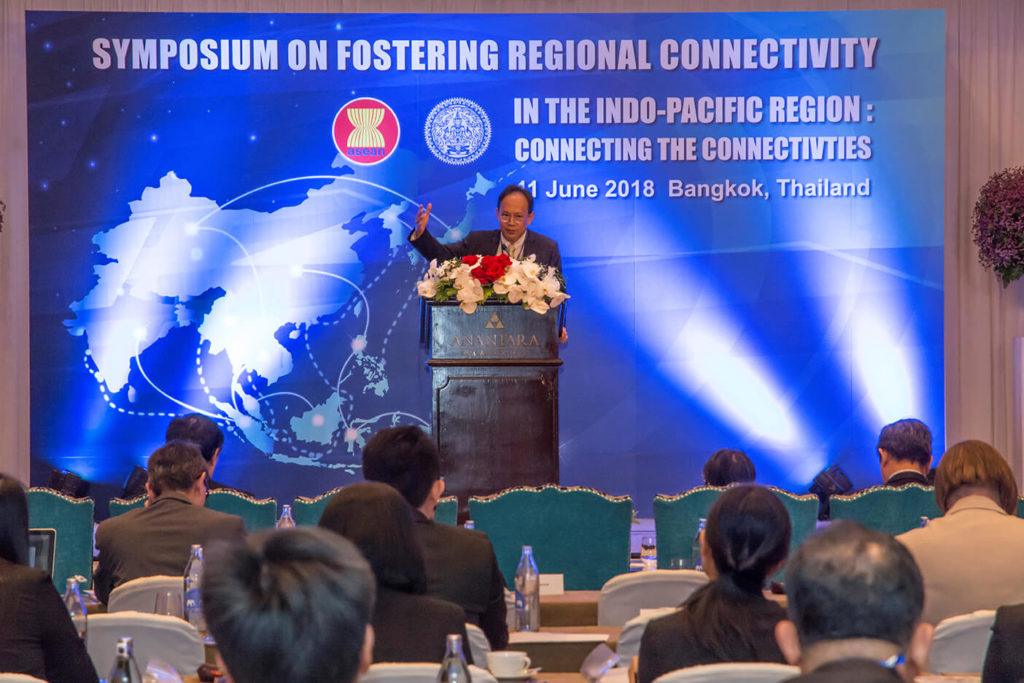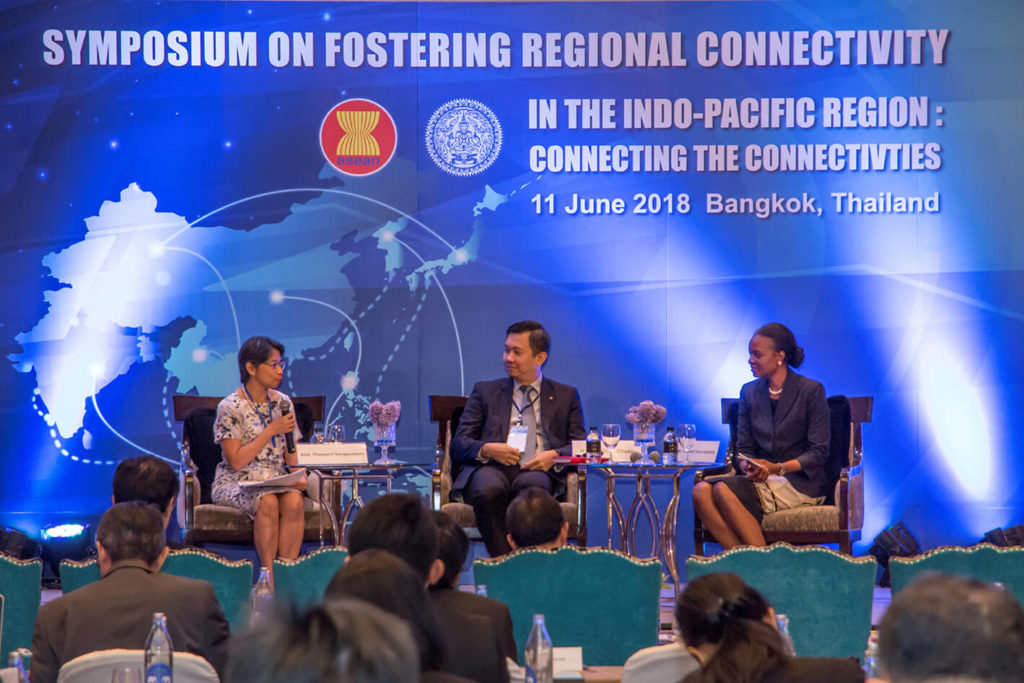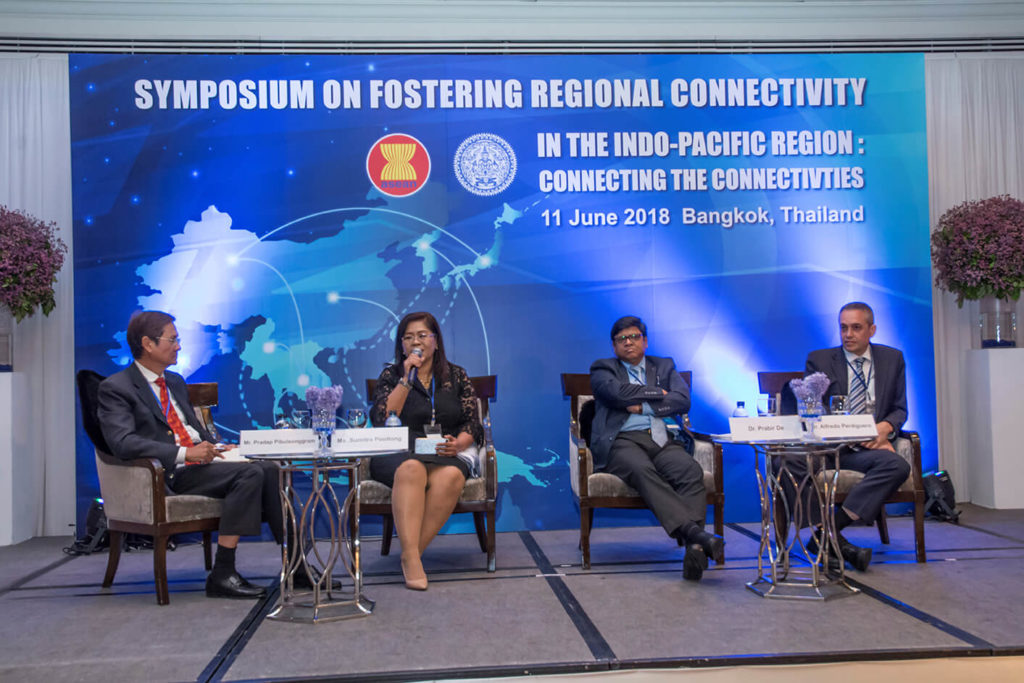
On 11 June 2018 the Department of ASEAN Affairs, Ministry of Foreign Affairs of Thailand organized a symposium on Fostering Regional Connectivity in the Indo-Pacific Region: Connecting the Connectivities in Bangkok. The Symposium discussed ways and means to promote regional connectivity, including cooperation and collaboration on regional connectivity among ASEAN Member States and beyond. In addition, participants exchanged views on how to translate MPAC 2025 initiatives into concrete projects and explored the complementarity between the Master Plan on ASEAN Connectivity (MPAC) 2025 and other infrastructure frameworks, such as Chinas Belt & Road Initiative, Japans Expanded Partnership for Quality Infrastructure, Indias Act East Policy, and other emerging initiatives such as ACMECS.
Distinguished panelists who provided valuable views and insights on various aspects of connectivities in the region included (1) Mr. Lim Chez Cheen, ASEAN Secretariat, (2) Ms. Fatouma Ibrahima,World Bank, (3) Ms. Sumitra Pooltong, Office of the National Economic and Social Development Board (NESDB), (4) Dr. Prabir De, ASEAN-India Centre (AIC), Research and Information System for Developing Countries (RIS), (5) Mr. Alfredo Perdiguero, Asian Development Bank (ADB), (6) Dr. Thia Jang Ping, Asian Infrastructure Investment Bank (AIIB), (7) Dr. Piti Srisaengnam, Chulalongkorn University, and (8) Dr. Fukunari Kimura, Economic Research Institute for ASEAN and East Asia (ERIA).

Dr. Suriya Chindawongse, Director-General of the Department of ASEAN Affairs, Ministry of Foreign Affairs of Thailand, delivered Welcoming Remarks on the need to develop greater synergies between various connectivity strategies in the region, while highlighting the importance of MPAC 2025 and ASEAN Connectivity. The key to developing greater synergies is to find effective but practical ways to Connect the Connectivities including addressing the sources of financing for this endeavour. It is important to increase dialogue amongst the proponents of the different connectivity strategies in the Asia-Pacific / Indo-Pacific region as well as amongst the international financial institutions / multilateral development banks.
The Symposium consisted of 3 parts (1) Promoting the Master Plan on ASEAN Connectivity (MPAC) 2025 with Other Sub-regional and Inter-regional Frameworks; (2) Connecting Regional Connectivity; and (3) Future Direction of Regional Connectivity in the Asia-Pacific/Indo-Pacific region, which were moderated by Ms. Phasporn Sangasubana, Permanent Representative of Thailand to ASEAN, Mr. Pradap Pibulsonggram, Advisor to the Department of ASEAN Affairs, Ministry of Foreign Affairs of Thailand and Dr. Suriya Chindawongse, respectively.
The three symposium sessions put forward the following key points and recommendations:
- Connectivity serves as a catalyst for economic and social progress and prosperity. It can be seen in three different levels: (1) Transport Corridors through rapid rails, low cost airlines and safety of the sea lines of communication;
(2) Economic Corridors through regional/global value chains, digital connectivity and border management (ASW); and (3) Sustainability Corridors which is the most comprehensive in scope, comprising inclusive and green growth, smart and sustainable cities, and the development of region-wide border management cooperation arrangement. - Connectivity should aim for more than physical connectivity. In addition to connecting two points, connectivity should also connect one person to another, and should go beyond ASEAN. Connectivity can serve as a bridge between regions as well as a catalyst with multiplier effects for sustained economic growth and sustainable development. There are several ways to promote connecting the connectivities in the Asia-Pacific/Indo-Pacific region: (1) promoting a strategic outlook to enhance regional connectivity by incorporating the various connectivity strategies in the region in a complementary manner. This would ultimately involve developing links between the connectivity agendas of the key connectivity strategies in the region, including, inter alia, the MPAC 2025, BRI, Partnership for Quality Infrastructure, Act East Policy connectivity and the ACMECS Master Plan, as well as other sub-regional connectivity strategies; (2) exploring connectivity projects that could complement and link up with one another across the different connectivity strategies, and (3) developing greater synergies amongst the efforts of the different international financial institutions (IFIs) / multilateral development banks (MDBs) in developing appropriate funding modalities to support the immense infrastructure financing needs of the region.
The Symposium was attended by over 100 participants from ASEAN Member States (AMS), the ASEAN Secretariat, international financial institutions (World Bank, Asian Development Bank, and the Asian Infrastructure Investment Bank), relevant experts, and stakeholders from public and private sectors. There were also observers from non-ASEAN EAS participating countries (China, The Republic of Korea, Japan, Russia, India, the U.S., Australia, and New Zealand).



*****************
Department of ASEAN Affairs
Ministry of Foreign Affairs of Thailand
August 2018
